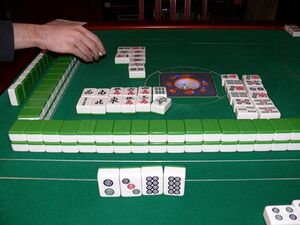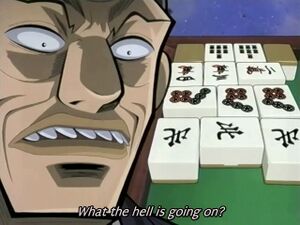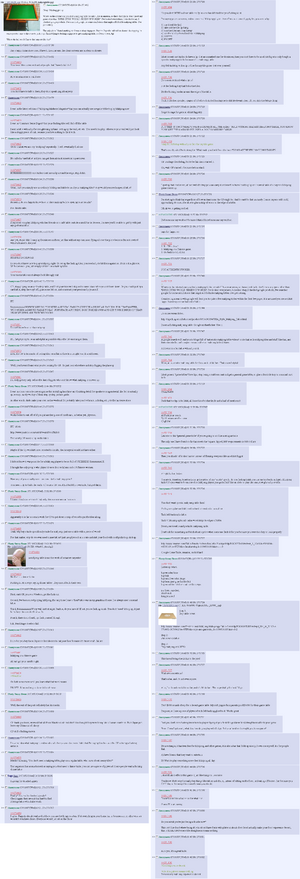Mahjong

Mahjong is a Chinese game about lining up tiles in a mathematically perfect fashion. The table must have a fucking lip, and making a lip out of balsa wood is unacceptable. You can only truly play Mahjong on a manufactured table. They take their Mahjong seriously, enough to bet money on it, and to have clockwork tables that shuffle and deal rows of tiles under the surface like something out of a James Bond film. The 'match-2' version you play on your computer isn't MahJong; it's called 'Shanghai' by white people and "that stupid game white people play" by the Chinese.
If you're gwailo, easiest way to explain this game is: it's almost exactly like Gin Rummy. You wanna make three-of-a-kinds and straights, the tiles have suits and ranks like playing cards, and you can pick up discards from the middle of the table.
But, since we're talking Asians here, the game itself has a bunch of subtle nuances, which seperate the rabble from the mighty mahjong masters.
There are several versions of Mahjong: Japanese Riichi, Hong Kong, classic (Hong Kong with flower tiles), american (which only elderly jewish women play) and Korean 3 player. However, the core rules are the same. Players take tiles from "The wall" and add them to their hand while discarding a tile. Simply put, the game is like a race, where players try to "complete" their hand quicker than others, while trying not to discard a tile that will cause another player to win the round.
A basic complete hand has four combinations of tiles which are either three of a kind, four of a kind or a sequence of three tiles (i.e. 1,2,3) in addition a "head", which is a pair of tiles. Apart from the head, you can call the other combinations from other players' discards, unless it's the last uncompleted thing on your hand . The special hands include all kinds of silly combinations; Such as having seven pairs. Important note: You can't win with a tile that you discarded earlier in the game. The rules on this aspect range from house to house.
Points are determined by how the player won the round. If another player threw away a tile that you grabbed and completed your hand with, that player has to pay the amount of points your hand was worth; If you claim the tile from the wall yourself, the price is split with the losers!
Mahjong is central in the Manga and Anime Legend of Koizumi, which is a series about former Japanese prime minister Junichiro Koizumi and various world leaders (and the Pope, and Hitler) playing Mahjong as part of political negotiations and TO DETERMINE THE FATE OF THE WORLD. It's a combination of the "card games descide everything" thing from Yu-Gi-Oh combined with Fist of the North Star. It is badass, funny and even tearjerking at times. Go look it up. NOW.
Luck, Statistics or strategy?

Beginners will notice that a lot of things in Mahjong are based on chance. Your place on the table, your beginning hand and draws from the wall etc. However, if you base your entire game blindly on luck, you might win some rounds but most of them will involve garbage hands, since you're not aiming for any special hands or trying to trick your opponents to fold their hands, because they think you have something monsterous there. And, most importantly, if you're just relying on getting some lucky tile before anyone else does, you're not watching whether or not your opponents might get their winning tile from you or way before you. In short: With luck you win battles but lose the war.
Regarding reading discards. To interpret hands on what players throw out beyond a shallow estimate is like trying to achieve immortality. Unless you're some sort of interdimensional demon, just forget about it.
But what you can do is use the mighty powers of probability and statistics to your advantage. Doing so, you have a better chance of predicting what is the most plausible, rewarding and fastest hand you could strive to from your beginning hand or should you fold it, if you think your needless discards will cause another player to win.
Some argue that success in Mahjong is based on "flow" and demons. Which is supposedly very evident in high-stakes games, where everyone has a great hand but one poor bastard is going to lose his left testicle at the end of the round. The aforementioned statistical thinking opposes this school of thought.
Regardless of your strategy: The main point in Mahjong is not to have the best hand, but to lose the least amount of money.

How to play?
By Sun Wu Kong, I thought I was thorough. The basic game requires four players. So get four of your friends or just azn people (they cannot resist a game of mahjong) and sit around a small square table that has a lip. Take out your $50 tile box and remove the flower and season tiles, because no-one uses those. Literally, playing with flower and season tiles is like playing without them.
Done that? Okay. Now shuffle the cards around, gradually turning them backside up. Make sure to make a lot of noise; it's a part of the tradition of Mahjong. Arrange the tiles in rows of 17 and stacks of two. Be sure to use the lip to straighten the stacks. This makes four walls with 34 tiles each.
Determine the dealer (East), thus the other wind directions. East throws two dice and counts counter clockwise East being one. The player the dice indicate will throw the dice again and cut his/her wall by the indicated number. From that number of tiles from right to left, count 7 (14 tiles) These are the "dead tiles" or "wang tiles", if you prefer. They will not be used in the game in this variation.
Starting from East, take turns grabbing four tiles per player left from the dead wall until you all have 12 in front of you. Now east takes two and the rest take one. East will now have 14 tiles in front of him/her, the rest have 13. East puts one of his/her tiles in the middle of the walls. You can view this tile as "I will not use this tile to win the round" for that specific player. The turn passes to the right, he/she takes a tile from the wall counter-clockwise and puts one tile in the middle. Now you know the plot.
Like mentioned earlier, you don't have to keep your hand concealed; you may call all your combinations from the discards. These combitations will be set aside to indicate your calls. If you called 3 of a kind and pull the fourth one from the wall, you may turn that pung, pon, whatever into a freaking kan, kong, whatever. Two players called on the same tile? chii<Pon<kan<win. After claiming a kan, take a replacement tile from the wall.

You can determine the payment on different hands by looking up the standardized competition rules.
Into the types of Mahjong
Like all card games, there's more than one way to play Mahjong. Here are the most played variations.
- Japanese Riichi: Arguably, the most popular form of Mahjong. Mainly due to its anime influence thanks to [mango|weeaboo]. This variation is very clinical compared to the other versions. For example: The furiten rule has bigger role, because every player places his/her discards front and center. This way, there is no doubt on what tiles the player is furiten for.
The main difference between other forms and riichi is the "riichi rule". Riichi (Or "reach" among amerifats) is when a player is one tile away from winning the round and decides to place a bet of 1000 points on the table. The player cannot alter his hand any further after this. You don't have to do this; but keep in mind that a hand has to adhere to specific criteria in order for it to be a qualified hand.
- Hong Kong: Filthy Chinese communists play this one. Tiles are tossed in the center willy-nilly and so the furiten rule is harder to uphold. It can also be played with straight discards.
- American: Same as classic, but contains flower as well as "joker tiles". Joker tiles act as wild cards, because "muh poker". Due to some odd twist of fate, the majority of American Mahjong players are old jewish women. I'm not even joking.
Mahjong clients
http://tenhou.net/0/ Riichi mahjong client. In the high likelyhood that you're not fluent in Japanese: click the blue text, press okay where the center bit says "NoName" and tick one or more of the boxes on the left
| Card Games | |
|---|---|
| Collectible Card Games: |
Call of Cthulhu - Cardfight!! Vanguard - Fire Emblem Cipher Force of Will - Jyhad - Magi-Nation Duel - Magic: The Gathering Netrunner - Pokémon - Star Wars: Destiny CCG (Dead) - Yu-Gi-Oh |
| Other Card Games: |
1000 Blank White Cards - 7th Sea - Apples to Apples - Bang! Cards Against Humanity - Coup - Decktet - Dominion - Dvorak F.A.T.A.L. - Keyforge - Mafia - Mag Blast - Mao - Munchkin Race for the Galaxy - Sentinels of the Multiverse - Tanto Cuore |
| Traditional Card Games: |
Bridge - Cribbage - Mahjong - Solitaire/Patience - Poker - Rummy - Tarot |